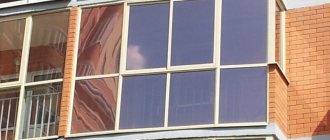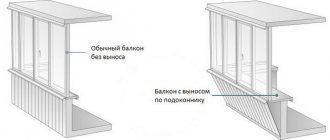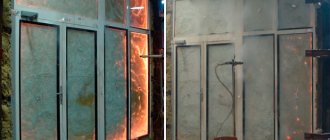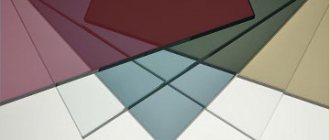On a hot summer day, when there are no clouds in the sky and the sun is at its zenith, it is unlikely that anyone will dare to go out onto the balcony, which is located on the south side of the house. Under the influence of direct sunlight, the air heats up so much that staying in such a room becomes extremely uncomfortable. The situation can only be saved by tinting the balcony - covering the surface of the windows with a special film that protects from the sun and performs a number of other useful functions.
The larger the glazing area, the greater the need for solar control coating.
What is tint film?
Everyone has seen a tint finish at least once in their life. This coating is often applied to glass facades of multi-story buildings, store windows and, finally, car windows.
The basis of most films on the domestic market is polyester. It goes through several stages of purification before undergoing a rolling procedure to obtain a uniform, ultra-thin (several microns) layer. The quality of the final product largely depends on the purity of the raw materials.
Note! Not all manufacturers of tinting coatings can boast of high-quality products. Among the companies you can trust are SunTek, SolarGuard, SunGuard, LLumar, Johnson.
Tinting has a multi-layer structure, where each segment performs a strictly defined function. The protective layer is responsible for the product’s abrasion resistance and ability to resist solar and temperature influences. When making films for tinting balconies, metal is often used. A metallized layer 1-2 molecules thick significantly improves the heat and light reflective properties of the coating.
Structure of a multifunctional tinting coating
Types of films
In order not to burden the potential buyer with information about the number of layers and the purpose of each segment, tinting manufacturers conditionally divide their products into several categories:
Sun protection
The main task of sunscreen coatings is to completely absorb ultraviolet radiation and filter visible light. Depending on the layers used, the film can either filter out narrow sections of the spectrum or uniformly filter all spectral components. A popular sun protection coating for balconies is mirror tinting. In this case, complete reflection of light occurs on the brighter side, while on the darker side the glass appears transparent.
Mirror tinting of the balcony
Protective
To increase the impact resistance of glass, a protective film with a “triplex” effect is applied to the surface. This coating is relevant for balconies on the first floor; it significantly complicates the task of intruders who want to break into the apartment. The peculiarity of protective films is their thickness. If regular tinting has a thickness of 20 microns, then protective tinting is 120-380 microns.
It is difficult to overcome an obstacle from a window with a protective coating
Energy saving
Energy-saving films are used to reflect infrared radiation (thermal energy) from the glass surface. The coating is functional on both sides. It retains heat inside the balcony during the cold season and prevents the room from heating up from exposure to the sun in summer.
The principle of operation of energy-saving windows
A specific film model does not necessarily have to belong to any of the listed categories. Tinting can simultaneously perform sun protection, protective, and energy-saving functions. It all depends on the number and characteristics of layers, the price of the product.
Tinting balcony windows: pros and cons
Tinting balconies and loggias is not cheap. Before making your final decision, find out all the advantages and disadvantages of tinting windows on your balcony.
Pros:
- Protecting the premises from harmful ultraviolet radiation.
- Protecting the room from external infrared radiation, retaining heat inside the balcony (for energy-saving models).
- Protection of glass from fragmentation in the event of an impact, explosion or strong gust of wind.
- Protection of the balcony from external eyes (with mirror tinting).
- Protects the window surface from static electricity, which leads to less dust attraction.
Minuses:
- A feeling of lack of daylight, an “early evening” effect for balconies located on the north side of the building.
- Possible weakening of the signal of mobile phones in the case of using tinting based on a dense metallized layer.
Note! The protective metal shield reduces the level of radio signals and electromagnetic radiation. Before tinting a balcony glazed from the floor, consult with specialists about choosing the optimal coating.
In order for tinting a glass surface to give a positive result, consider the location and nature of the balcony glazing
How to close windows on a balcony from the sun: choice of materials
Modern hardware stores can offer a huge selection of tinted films to suit every taste and need.
But it is necessary to understand the diversity of these films. You can close the windows on the balcony from the sun using various types of tinted films:
- Shockproof, protective;
- Sun protection;
- Camouflage or mirror;
- Reflective, lowers the room temperature in hot weather;
- Combined, anti-vandal.
It is necessary to consider all the pros and cons of these types of tinted films. Protective shockproof tinted film will protect residents from glass fragments upon impact. Especially recently, sun-tinted films have been in demand. They perform their direct function - protecting the room from excessive solar insolation and heat.
Another very popular type of tinted films this season is camouflage or mirror film. First of all, it has become so popular due to its unique properties. Inside, residents see everything perfectly, but outside, they become invisible. Simply a unique property. The hidden dream of every person is to be invisible, and at the same time, to be an observer. And making your private life and the life of your family inaccessible to others also adds to the popularity of mirror films. But there are other unique properties of this film - it is an excellent reflector of not only sunlight, but also heat. The industry produces a wide selection of colors of mirror tinted films.
Thanks to the strength of the protective film, criminals can hardly break into your home, even if the window is broken. This film is also an excellent sound insulator, protects against external noise from the street and prevents listening from outside the apartment.
DIY balcony tinting
To save money, you can tint the windows on your balcony yourself. It is enough to strictly adhere to the film gluing technology.
Choice of tint
In addition to the structure and energy-saving characteristics of the coating, an important parameter that you need to pay attention to when choosing a material is light transmittance. This characteristic is usually displayed as a percentage and means how much light will enter the room. For example, “film 35” transmits 35% of the light spectrum. The more an object is exposed to direct sunlight, the lower the light transmittance should be.
Light transmittance of different tints
Film gluing technology
It is better to apply sun protection coating from the inside of the window. This way the material will be less exposed to external influences and will last longer.
The procedure for tinting glass on the balcony:
- Remove the side and bottom beads holding the glass unit in the window frame. If you do not plan to completely remove the glass unit, it is better to leave the top bead so that the glass does not fall out.
To remove the bead, use a special puller or thin plate
- Measure the glass size and cut the film
For cutting, use a construction knife with a sharp blade
- Wash the window thoroughly. Any detergent, such as Gala, and a scraper will do.
After washing, make sure that there are no lint, drips, or fingerprints on the glass.
- Remove the protective layer from the film and moisten it with water. Moisten the glass surface.
The use of water avoids creases during installation
- Apply the sun protection coating to the window and remove the water from under it with a squeegee or a regular plastic card.
The squeegee movement should go from top to bottom or from the center to the side edges
- Place the beads in place.
Finished tinted window
Dismantling and installation of plastic window beads can only be carried out if you have the appropriate skills. Otherwise, there is a high probability of damage to the window frame or glass unit.
We tint windows if the glass is removed from the frame
In this situation, all glass must be removed from the frames and washed very well. Window tinting film is also cut to size and with a small allowance.
The soap solution is applied in the same way to dry glass and the adhesive side of the film. The remaining film on the edges of the glass is carefully trimmed with scissors and the glass is inserted back into the frame.
If you are afraid that dust, dirt or air will get under the film, then you should try the gluing method by completely immersing the glass in water. After the film has been glued, you need to let the glass dry, and only then insert it into place.
Useful video on the topic
Detailed video instructions for installing mirror film
External ceramic film without window tint
Tinting a balcony with a mirror or any other film does not require special care for the windows. To keep the glass in good condition, ordinary water or a non-aggressive detergent is sufficient. The service life of a quality product reaches 10 years. On a cheap analogue, after 2-3 years coating defects appear and the material loses its sun protection properties.
YOU MAY ALSO BE INTERESTED
How to care for tinted glass
Despite the fact that the film requires virtually no special care, sooner or later you will have to wash the windows on your balcony. In addition, it often happens that glass becomes dirty not from dust, but from ordinary dirt from flower pots or splashes of food and drinks.
Some tips for caring for tinted windows:
- When washing tinted windows, do not use hard sponges and, especially, brushes. This will damage the surface and cause scratches;
- Wet cleaning of windows should be carried out at least once a month;
- When cleaning with soap, do not use aggressive cleaning agents. Liquid baby soap diluted in water is best;
- A microfiber cloth is good for removing dust;
- If bubbles appear, they can be easily removed using water and a syringe. First, puncture the bubble, fill it with water, and straighten the surface with a soft cloth or spatula.
Sources
- https://build-experts.ru/tonirovka-balkonov-i-lodzhiy/
- https://zonabalkona.ru/okna/kak-sdelat-tonirovku-samomu.html
- https://balkonoved.ru/remont-i-otdelka/vidy-tonirovochnoj-plenki-i-sposob-montazha-na-balkon-ili-lodzhiyu-svoimi-rukami-poshagovaya-instruktsiya-s-foto-i-opisaniem
- https://bezkovrov.com/lodzhija-i-balkon/tonirovka-balkona.html
- https://balkon.expert/osteklenie/okna/tonirovka-balkonov-i-lodzhij.html
- https://dom-i-remont.info/posts/balkon/tonirovka-balkona-svoimi-rukami-terpenie-i-trud-voznagradyat-spolna-hozyaev/











